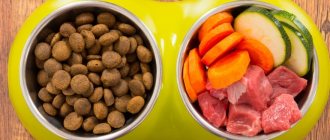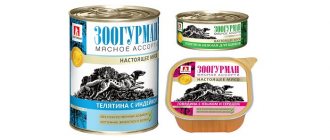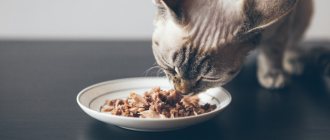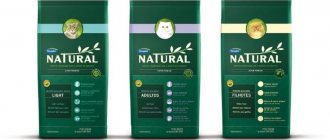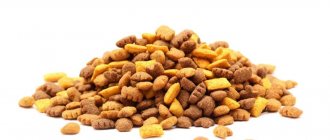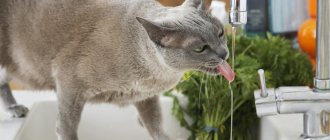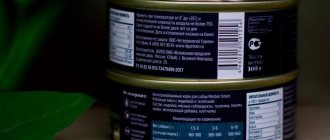You can talk for a long time about how to switch a cat to a natural cat. But in the end it all comes down to a few techniques. If the animal is not accustomed to eating meat, then it needs to be taught this. After all, the “factory settings” of the cat’s body are designed specifically for the consumption of meat, and not dry pads.
It is possible to train a cat to eat raw meat at any time and at any age. You need to remember this, because some animals try to prove the opposite with their behavior. As a result, the process drags on for months and ends with the owner’s capitulation.
Why is this happening? Because cats are cunning creatures. And domestic cats, as a rule, are also overfed. Therefore, they can afford to sort out grub and educate the owner.
So how do you train a cat to eat meat?
Mix meat into food
If you're up for a multi-week journey, gradual food switching may be an option for you. To do this, they begin to add a little raw meat to the usual food. Gradually, in portions, the amount of feed is reduced, and the amount of meat is increased. And so on until the moment when only meat remains on the plate.
Abrupt refusal of factory feed
The second path is suitable for those who are ready to overpower the cat’s character. The food is abruptly stopped and only meat is given. At first you can baked or boiled, because... it looks more like food.
The cat may react negatively to this turn of events and completely refuse to eat for several days. In this situation, it is important not to give up and not give the usual food, no matter how the animal begs. As a result, after a few days the cat gives up and begins to eat the food offered.
EXPERT COMMENT: veterinarian-felinologist Yulia Brovko
This method works in 90% of cases, but many are afraid of it because of the danger of developing liver lipidosis. This condition most often occurs in overweight cats that have been fasted for long periods of time. If your cat is young, healthy and not overweight, then fasting for up to 4 days will not cause lipidosis, but you will achieve the desired result.
During the game
The author’s cat, who had been eating cooked meat all her life, was taught to eat raw meat through play. During the game, they began to use not a mahalla, but a piece of meat. The cat had to hunt him. And since during the hunt, when a cat catches something, it instinctively takes it into its mouth and chews it, having caught the meat, it began to do the same with it. The meat turned out to be tasty (of course, it was quail!) - and since then the cat has only eaten raw.
Using baked meat
Another way to get your cat interested in meat is to boil or bake it, and then chop it finely so that the pieces become the size of drying pads. Then it looks more like food, and accordingly, the cat may be more willing to try such a product.
If the cat eats factory-made pates, then grind the meat in a meat grinder and make a pate. Pates and minced meats are not suitable for permanent nutrition, but for the transition period they can be a lifesaver.
Using an attractant
Natural attractants are also used as a trick. Many cats love the smell of fish. Therefore, the meat can be poured with canned fish juice.
Try different types of meat
Typically, cats do not like all types of meat equally. Therefore, if you tried only one type and the cat refused it, this does not mean that he will refuse the other. Experiment! Hint: most often cats love liver and heart.
Reasons for changing your diet
The main reason is indisputable evidence that natural food is healthier than any prepared food.
You need to change your diet if the following symptoms appear:
- Frequent gastrointestinal problems: constipation, diarrhea, diarrhea.
- Constant belching and regurgitation, bloody salivation.
- Excessive hair loss and bald patches.
- Recommendations from a veterinarian in connection with the developmental characteristics of the animal, as well as after surgical operations.
- Improving the pet’s quality of life and improving its condition.
Transition rules
In order to transfer an animal to a new diet without consequences, it is necessary to adhere to certain rules for the transition. Moreover, in the case of dry food and natural food, there are some nuances.
Something else interesting: Meat components of artificial cat food
Dry
When choosing such food, you should give preference to super premium and premium class. The transition is completed within 7–10 days. The animal must be healthy, not pregnant, playful and have regular bowel movements. It is not advisable to switch pets who drink little water to dry food. Otherwise, problems with the bladder and kidneys may occur.
On the first day of changing your diet, you can ignore the dosage. In the first two days, the new food comes as supplements (10–15 “crackers”) to the old diet. It is necessary to soak the dry food a little. Remember that from this time on, your pet should always have enough water. On this diet, the cat will drink 4 times more water!
With each subsequent day, you need to double the dosage of soaked food, while simultaneously reducing the previous diet. By day 10, you should completely change the type of food. A single dosage depending on the age of the pet is indicated on the package.
After switching to dry food, the cat can no longer be fed with natural food or vitamin supplements.
To natural
There are situations when a cat needs to be switched to natural food. Several methods can be used to make this transition.
The forceful method involves stopping the distribution of dry food. In this case, the animal should be offered foods that are easy to digest (offal, boiled chicken meat, cottage cheese), since the previous diet “weaned” the stomach and intestines from proper enzymatic digestion. Food is given in cut pieces, which should be identical in size to dry food. The disadvantage of this method is that the pet may be stubborn and simply go on a hunger strike. In this case, the cat may develop health problems (especially with the liver).
The persuasion method involves gradually reducing the dose of dry food and offering the pet some treats. The choice of treats depends on the individual preferences of the animal. As a result, without unnecessary stress for the cat, it can be gradually switched to natural products.
Something else interesting: Sources of carbohydrates for cats
The mixing method involves adding canned meat to dry food. Gradually the second component should become dominant. You can also gradually introduce vegetables into your diet. The disadvantage of this method is the duration of the transition.
Simultaneously with the transfer, you need to give your pet a complex of lacto- and bifidobacteria or special enzymes. Such supplements will help the intestines restore their function faster.
What not to do
When transferring a pet to a new food format, you should not mix certain types of food (indicated on the product label), or force the animal to eat new food. The cat may independently refuse the new diet, preferring to go on a hunger strike. Without food, a cat can live for three days, after which disturbances in the liver (lipidosis) will begin or gastrointestinal tract disruption will occur, which can lead to death.
It is also prohibited to change the diet at once. The transition had to be smooth, then it would go smoothly and unnoticed by the pet.
The transfer of domestic cats to a new food format should always be carried out according to the rules described above. This is the only way to keep your pet healthy.
Disadvantages of dry food in cat nutrition
Industrial feeds are addictive because they contain a large number of additives. Popular brands do not contain essential microelements; their minimal amount does not cover the damage to the digestive system caused by other ingredients. Long-term consumption of dry food leads to diseases of the digestive and genitourinary systems, stomach, and kidneys.
Causes and consequences of an inadequate cat diet
- Reason: High carbohydrate content in the feed. Consequences: Colic, bloating, ulcers, constipation, kidney failure.
- Cause: Insufficient fluid intake. Consequences: Constipation, kidney stones, kidney disease.
- Reason: Flavorings and flavoring additives in food. Consequences: Increased blood sugar levels and diabetes.
To normalize the functioning of internal organs, you need to feed your cat natural food. A change in diet can be temporary or permanent, depending on the veterinarian’s recommendations and the animal’s well-being. The minimum period for alternating food is 3 months. Frequent changes or combined meals will lead to poor health and diarrhea.
What is artificial food?
They write a lot about them, they also talk a lot, but they talk mainly about which class of food is better - premium or economy? It is not often discussed whether there is a need to feed a cat artificial food. Whatever one may say, lazy owners buy canned food and “crackers” for pets. Yes, yes, let's call everything by its proper name. Isn't that true? First of all, we try to take care of ourselves by getting rid of the fiction of “what should I feed the cat today?” The easiest way is to buy a jar of canned food, open it and pour it into a bowl.
In addition, thanks to advertising that contributes to the growth of popularity, our concept of a proper cat diet has been distorted to “I can’t.” Advertising “educates” us about the value of cereals and other silage for what is essentially a carnivorous animal.
Rules for changing the power system
It is necessary to gradually transfer an animal from one type of food to another. Because a sudden change will lead to stress. Keep in mind that with long-term consumption of a certain food, the cat develops a habit and taste preferences.
There are 4 ways to change your diet:
- Radical - strict abolition of dry food, a sharp change from dry granules to natural products.
- Loyal – gradual introduction of natural products, switching the animal’s attention to similar homemade products.
- Combined – aimed at gradually acclimating the animal with a decrease in the proportion of dry food in the daily diet.
- Canning - changing the diet first to wet food and then to natural food.
Transfer to natural food
Natural food refers to raw foods that are available to a cat living in its natural environment.
Accustoming a cat to new food is not easy, but it is possible even with a long history of dry feeding.
Accustoming a cat to new food is not easy, but it is possible even with a long history of dry feeding
Due to the lack of a familiar smell, the cat may not initially understand that there is food in front of her. An animal that is carnivorous by nature will stubbornly refuse all natural delicacies and persistently demand familiar food.
Be sure to read:
How to feed a cat correctly: natural or dry food and how many times
The main condition for switching to a different diet is the complete absence of dry food in the apartment. A cat's sensitive sense of smell will detect its scent anywhere. Before weaning your cat off drying, you need to think through the diet and prepare food in advance.
The transition sometimes lasts more than a month. In difficult cases, the functioning of the digestive tract in animals is disrupted. The owner needs to act gently and not put pressure on the pet.
No dry food - a radical method
There are 4 main stages of transition:
- Preparation - natural and dry food are mixed, with a minimum amount of granules. This nutrition system lasts for 2-3 days.
- Adding biological additives. To stimulate the gastrointestinal tract, vitamins are added to food to stimulate the digestive system.
- Cleaning up dry food - you can’t hide it, it’s important to completely remove the food from the house so that the cat doesn’t smell or hear the familiar rustling sound. Donate food to pet-loving neighbors or feed homeless animals.
- No concessions - the cat may refuse to eat for several days, but it will not be able to starve itself and will begin to eat unusual food. You should not succumb to your pet’s “provocations,” as he will quickly understand how he can get his usual food.
The period of adaptation is 3-14 days.
Important! This method cannot be used to change the diet of kittens under 12 months of age, since their digestive system is not yet fully formed.
Transferring the cat to homemade food
You can continue to feed the animal its usual food, gradually mixing in various ingredients of another product until a complete replacement occurs. The new type of food should be given to the animal in small quantities in small pieces, no different in size from normal everyday food. After 4-5 days, the volume of dry food is reduced to 50%, then the replacement occurs completely within 10-15 days.
If the pet prefers certain products in addition to dry food, temporarily limit them only to them until the cat is completely weaned from “drying”.
If it is difficult to determine your pet’s taste preferences, it is worth offering several different dishes, placing them in different bowls. The cat will choose and take a liking to the new food, then the cat will be completely switched to homemade food.
There is an option when the volume of regular food is reduced, and the animal, without being completely full, is saturated with another product, homemade, located close to the main, regular food.
Usually, a cat’s refusal of new food plunges the owners into panic - they worry that the pet will become exhausted, get sick, or die. But the animal will not die of hunger if there is food nearby, even if it is tasteless and unloved. Fears are unfounded, remember that you are acting for the benefit of your pet, the cat will humble itself and accept your conditions.
Loyal transition method
The cat is given 2 bowls of food. One contains the usual dry food, the other contains homemade food. Gradually, the volume of dry food is reduced, after which the animal stops eating and involuntarily switches its attention to the bowl standing nearby. To increase the appeal of home-cooked food, add meat to it. In the first days, cereals and meat can be mixed with a blender to create a pleasant, homogeneous consistency.
During the weaning period, add vitamins to maintain the balance of nutrients in your pet's body.
The transition period is 14-21 days.
Ways to switch to natural food
When, for various reasons, the owner decides to wean a cat off harmful dry food, he needs to be patient. Some animals resist for a short time, others persist for a long time, leading their owners to despair.
But the natural survival instinct will definitely work - the cat will start eating. No animal voluntarily dies of starvation when there is a bowl of food nearby.
There are different ways to switch to a different diet. But in all cases it is based on natural meat.
Force method
Do not give in to pity and stop dispensing dry food completely . Offer easy-to-digest foods and offal, cut into pieces.
Do not give in to pity and stop dispensing dry food completely
Give food strictly on time; after a quarter of an hour, remove the bowl in any case so that the food does not turn sour. The animal will eventually understand that there will be no other food. Clean water should always be available.
A sudden switch to natural food often leads to hunger strikes and digestive problems. If the cat does not eat for a long time, then it is better to try another method.
Persuasion method
If, in addition to dry food, the cat has other treats, then you need to increase their quantity, reducing the portions of drying. In this way, you can wean the animal off artificial food, but at the same time accustom it to other food of little benefit.
Reduction method
You can try to gradually reduce the portion of artificial food. Having not eaten enough dry food, the cat will finish eating natural food from another bowl. Gradually, over the course of a week or two, he will get used to the new food.
Be sure to read:
Food for sphinxes, what to feed a kitten and an adult cat: menu by month
Mixing Method
This method takes a long time, but is the most gentle and effective. It is necessary to gradually reduce the share of artificial food day by day, adding natural food.
Add canned meat to drying, mix with meat and vegetables, increasing their quantity. Time will pass, and the animal will not even notice the absence of its usual food.
Such a smooth transition will take place without negative consequences for the animal’s digestive system. Adding catnip to your new diet will speed up the adjustment process.
Attention! With any method, it is important to give your pet vitamins to maintain the body. The veterinarian will give advice on their choice, taking into account the weight and age of the animal.
Wet food and canned food
The most gentle way for a cat’s digestive system is to replace dry food with canned food containing the usual flavoring additives, and then with fish and meat mixed in a blender.
Replace dry food with canned food for 7-14 days, after which gradually introduce homemade food.
Add one by one:
- boiled meat - rabbit, turkey, veal and lean pork;
- vegetables;
- porridge.
The consistency with canned food is made the same to achieve maximum similarity. The transition period takes 91-120 days.
Pros and cons of natural nutrition
The main advantage of switching your cat to homemade food is that you know exactly what you are feeding your cat. The quality of food from the store is sometimes questionable, but here it is real food, prepared by the owner himself.
One of the disadvantages is that if the cat eats natural food, it can become infected with parasites. The problem can be solved by heat treatment of meat and prevention of worms in cats.
In addition, unlike food, you will have to spend time preparing food. And not only for cooking, but also for thinking through the diet.
The idea should be abandoned if you often leave and give the cat under the care of other people. Constantly changing food from natural to food and back will only harm the cat.
Also, do not switch your cat to natural food if you follow a vegetarian diet. Cats are predators, and they cannot live without meat, and it will be difficult for a vegetarian owner to cook meat.
Natural or balanced food for adult cats?
Many cat owners choose dry food for cats and kittens, but some remain committed to the misconception about the benefits of raw meat, fish and fresh dairy products. Myths about the benefits of “natural food” for felines have long been dispelled by veterinarians, manufacturers of pet diets, and store specialists in the selection and sale of all types of food. Compared to meat, fish and other products, ready-made pelleted feeds have many advantages:
- Balanced – dry cat food should consist of proteins, fats, carbohydrates, digestible fiber, and a vitamin-mineral complex; it is best to purchase them in specialized online stores.
- Easy dosage according to the age and weight of the animal;
- Ease of combination of dry/wet food and traditional products;
- Elimination of poisoning, which often occurs when feeding meat/fish with a large amount of premixes;
- The ability to choose daily, preventive and therapeutic dry food for cats of any age group.
How to switch a kitten from natural food to industrial food
It is much easier to accustom a kitten to dry kibble if it is its first food after cat milk. If the pet has been on natural food for some time, changing the diet can cause certain difficulties. It is also important to act gradually:
- From 1 to 4 days - the same natural diet is left (3 parts), dry food is added at the rate of 1 part of the volume of other products.
- From 5 to 8 – the amount of industrial and natural food is the same.
- From days 9 to 13 – granules and natural products are mixed in a 3:1 ratio.
- From the end of the second week, the food is completely industrial.
Despite all the benefits of high-quality dry food, veterinarians do not recommend feeding a kitten only with granules. It is better to mix dry and wet food.
How to switch a cat to dry food
Before changing your pet's diet to dry food, take a closer look at his habits and behavior. If you notice that your cat drinks water in small quantities, then do not rush to switch to dry food. This can cause disruption of the animal's urinary system. After all, if a cat drinks little water, it means that it makes up for its deficiency from liquid food. If you have finally decided on the transfer, then at first, when feeding dry food, add a small amount of water to the food.
